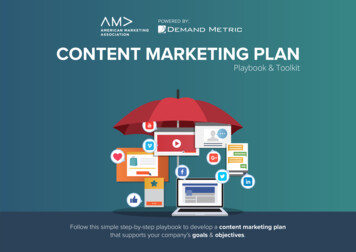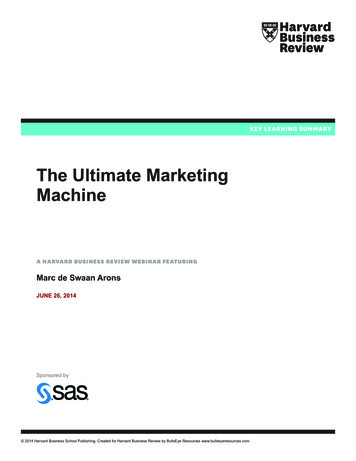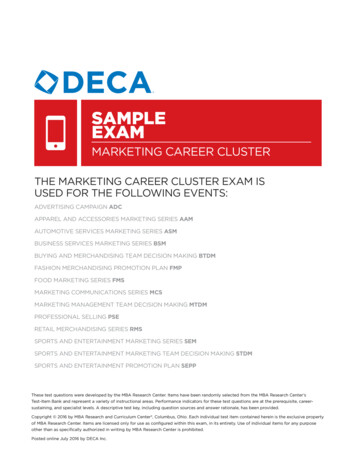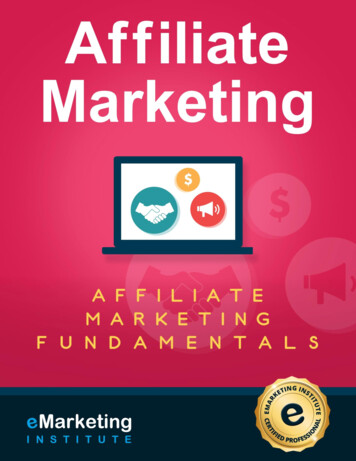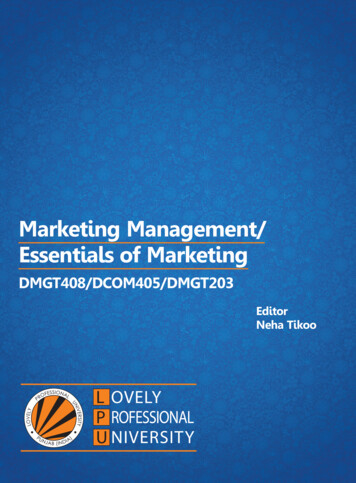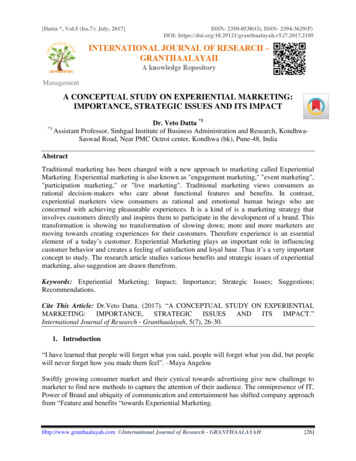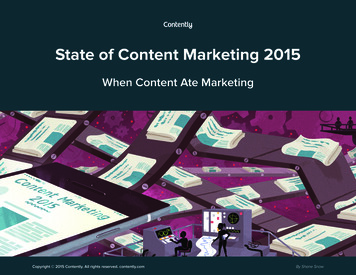
Transcription
State of Content Marketing 2015When Content Ate MarketingCopyright 2015 Contently. All rights reserved. contently.comBy Shane Snow
STATE OF C ON TE N T MARK E TIN G 2015: W H EN C O N T EN T AT E M A R K ET I N GContent marketing is the only marketing left.-SETH GODIN2CONT E NT LY
STATE OF C ON TE N T MARK E TIN G 2015: W H EN C O N T EN T AT E M A R K ET I N GTable of ContentsI.IntroductionII. What Will Work in 2015349III. What Won’t Work in 201513IV. Where We’re Headed19CONT E NT LY
STATE OF C ON TE N T MARK E TIN G 2015: W H EN C O N T EN T AT E M A R K ET I N GThis morning I woke up, stretched, and said to myself, “You know what I could really use today? Arelationship with a brand.”That’s not true. (Not even the stretching.) But someone in nearly every company in America wokeup today wanting to build a relationship with me.More precisely, today’s savvier brands are trying to win me over by creating stories and games andmovies and educational materials they think I’ll like instead of interrupting me with ads I don’t careabout or trying to butt into my social life. In other words, trying to be “friends” with me the way realfriendships are formed.That give-first mentality is the essence of a good relationship. It’s also increasingly true of contentmarketing, which as of 2015 is officially the fastest-growing marketing channel for most businesses.(For a primer on content marketing and all its definitions, see our Content Marketing Dictionary.)4CONT E NT LY
STATE OF C ON TE N T MARK E TIN G 2015: W H EN C O N T EN T AT E M A R K ET I N GIf the 21st century is the era ofdemocratized publishing, the2010s are the decade of brandpublishing.MEDIACOMPANIESCOMMERCIALBRANDSAnd 2015 is a year of convergence, where the content businessfurther shifts from a media-corporation model (make content,sell ads) to a corporate-media model (make content, get customers). This is happening to both traditional and new publishers.(Read more on the future of business models of journalism here.)Before the Internet, content marketing was the domain of a smallnumber of companies that had publishing in their DNA—really,media companies that had something to sell. Cookbook makers who sold kitchen supplies. Business newswires that soldcomputer terminals. Today, between 80 and 90 percent of U.S.businesses use content for marketing in a strategic fashion. Halfof those businesses spend 25 percent of their marketing budgetson content.5CONT E NT LY
STATE OF C ON TE N T MARK E TIN G 2015: W H EN C O N T EN T AT E M A R K ET I N GIn 2014, brands did more content marketing than ever. (We high-Social content: using "micro content" to spark conversations andlighted the best branded content of 2014 here.) Everyone and theirbuild communication channels on social networks. Essentially,pet ferret started a content marketing agency. Agencies (creative,this is social media marketing, but people call it content mar-media, and PR) skated onto the content marketing rink en masse.keting or social content. E.g., the many, many pancake GIFs thatAnd in the process, three main content marketing strategiesDenny's posts to Tumblr. (Read more about "microcontent" andemerged:other content marketing buzzwords here.) PR and social mediaOwned content: publishing to one's own publication. E.g., GEagencies typically push this strategy.Reports and Amex OPEN Forum. This is an "always-on" contentThese strategies are being powered by a new world of technologymarketing strategy, often promoted by PR and creative agencies,platforms, sponsored content studios, and content distributionor run internally by brands willing to make long-term invest-services, as you’ll see in the map on the next page.ments in content marketing.Rented content: paying a publisher to publish an advertiser'scontent (whether written by the advertiser or by the publisher).E.g., This beautiful piece for Cole Haan created by The NewYork Times' T Brand Studio, or these bonkers sponsored listicleson BuzzFeed. Typically, these are labeled "sponsored content,"and are promoted by media buying agencies (who aim to makeprofit by selling content like they do advertising inventory) andtraditional media (who aim to further monetize their publicationsthrough brand content).6CONT E NT LY
STATE OF C ON TE N T MARK E TIN G 2015: W H EN C O N T EN T AT E M A R K ET I N G7CONT E NT LY
STATE OF C ON TE N T MARK E TIN G 2015: W H EN C O N T EN T AT E M A R K ET I N GAt Contently, we’ve experienced all sides of this world. Our technology platform helps power brands like American Express andCoca-Cola that have built publications that millions of peoplevisit each month, and we grew as a brand publisher ourselvesin 2014—dramatically so. The Content Strategist quadrupled inaudience, garnering a million minutes of attention time in Q4.(Read more on Contently Insights and the importance of attention time here.)As a result, we’re fortunate to see a lot of industry trends beforethey unfold. Here’s what we see happening in the next 12months:8CONT E NT LY
STATE OF C ON TE N T MARK E TIN G 2015: W H EN C O N T EN T AT E M A R K ET I N GWhat will work in 2015Before the Internet, publishers needed three things: talent to find and produce stories, a press to printstories, and trucks to deliver stories to newsstands and doorsteps. Back then, publishers learned abouttheir stories’ effect on their audience via newsstand sales figures and letters to the editor (and sometimes changes in politics and society). Humans and analog technology did each of these jobs forcenturies.That was the common model that worked for analog publishers: Produce stories, deliver them to theaudience, and use audience clues to divine what worked and didn’t.In the Internet age, smart digital publishers—folks like BuzzFeed and Mashable—have essentially usedthe same process with new tools: Use tech-savvy talent to find and produce stories and print them tothe web using a content management system (digital “printing press”), send the stories out to audiencesvia social media and native advertising (digital “trucks”), and measure the results using analytics (digital“newsstand figures”). Really smart publishers use those analytics to inform their next round of publishing.9CONT E NT LY
STATE OF C ON TE N T MARK E TIN G 2015: W H EN C O N T EN T AT E M A R K ET I N GAt Contently, we boil down that process of being an effectivepublisher to “C.E.O.”: create, engage, optimize. We call it theflywheel:CREAT EAt many brands, what used tobe an audience-reaching effortis increasingly shifting to anaudience-building effort.Instead of treating content as ads with a shelf life, they’re seeingcontent as a way to build an asset. This has increased in priorityas social networks tweak their algorithms, making it clearer thatMEIZENTIGAOPGEbrands don’t truly own their audiences.10CONT E NT LY
STATE OF C ON TE N T MARK E TIN G 2015: W H EN C O N T EN T AT E M A R K ET I N GThat’s where the flywheel becomes the proper paradigm forcontent marketers as well. When you organize a content marketing strategy around these three audience-building initiatives,the optimal place for using owned versus rented versus socialcontent becomes clear:OWNED CONTENTCREAT EIn 2015, we’re going to seemore companies convergetheir disparate contentstrategies into one strategythat points toward ownedcontent first.brands building their own publications and using rented andsocial content as mechanisms for drawing audiences to theirown turf. There, the brands have an opportunity to build directGEMEIZENTIGAOPOWNED CONTENTrelationships with their readers and viewers. As such, we’ll seeOWNED CONTENTRENTED CONTENTSOCIAL CONTENTa lot more emphasis on racking up email subscribers (wherea brand has direct access to its audience, Facebook algorithmchanges be damned!) and less emphasis on building social mediafollowings. Instead, social will be properly viewed as a channelfor distributing your content and attracting readers who willbecome direct email subscribers.11CONT E NT LY
STATE OF C ON TE N T MARK E TIN G 2015: W H EN C O N T EN T AT E M A R K ET I N GTo make the flywheel work, content marketers can no longerThis owned-first, rent- and social-second strategy is going to beignore software. And as I mentioned before, technology compa-the most effective plan for brand publishers moving forward. Innies are racing to provide solutions across each piece of it. Here,fact, the brands that have gotten the most bang for their contentfor example, is how we use some of the primary players on thatbuck—and who get the most sustained industry cred—are thetech field (including our own products) to make Contently’s owncompanies that have jumped all in on owned content: Red Bullflywheel work:(with its separate business unit for media, Red Bull Media House),American Express (disclosure: a Contently client), and Marriott,which just went all-in by building a 65-person content studio.(For more on the optimization piece of the flywheel and the ROIAT ECREof content marketing for B2B and B2C brands, see our guideMEIZENTIGAOPGEhere.)12CONT E NT LY
STATE OF C ON TE N T MARK E TIN G 2015: W H EN C O N T EN T AT E M A R K ET I N GWhat won’t work in 2015In the last few years, our neighbors have learned a few brand content lessons for us the hard way. Here’swhat won’t work for brands in 2015 and beyond:NON-INDEPENDENT NEWSIn 2014, we witnessed the boisterous rise and messy explosion of Verizon’s brand publication, SugarString. The cause of the crash? Verizon tried to do “the news” as a brand with a stake in shaping saidnews, banning coverage of sensitive topics like the NSA. As I wrote in my recent essay about businessmodels of journalism, brands can thrive as publishers of education and infotainment, but will have ahard time acting like news organizations. To be honest, they shouldn’t even try.Read more on the SugarString snafu and the lessons learned here. The main message: Brands can begreat magazines, but ought not to try being digital newspapers.Inauthentic content—like the “health” stories by Chik-fil-a documented in this story—won’t work forbrands in the long run either. The common element to both of these is the refrain we repeat every dayhere and cite in our Content Marketing Code of Ethics: Don’t betray the reader.13CONT E NT LY
STATE OF C ON TE N T MARK E TIN G 2015: W H EN C O N T EN T AT E M A R K ET I N GCONTENT LICENSINGI talked about this in last year’s State of Content Marketing, butpublished elsewhere is not going to get them very interested inI’m mentioning it again because we have another year of data tovisiting your website.confirm:For brands, licensed content simply doesn’t work.Zero brands got organic traction, attention, or built an audienceusing licensed content in 2014. Many tried, and 100 percentflopped.Because of social media, the era of the aggregator portal is over.Today’s big remnant portals—Yahoo, MSN, etc.—increasingly create original content in additional to the content they syndicate.The biggest portals today for aggregated/curated content aresimply Reddit, Twitter, Facebook, Tumblr, and the like. A brandlike Nike or Ford is not going to compete with those websitesIf you’re trying to build a relationship with someone in real life,on that battlefront. But the reverse strategyis effective: Nike orre-gifting them something they could easily get on their own isFord can leverage portals and aggregators to spread their originala bad strategy. Telling them a story they already heard is a badcontent.strategy.“Syndicated content is likegiving popcorn to children,”Moz’s Cyrus Shepardrecently told me. “It will keepthem busy for a while but thatsit.As a wise ad man once said, “It is better to be syndicated than tosyndicate.”Licensed content has been an attractive proposition because it’scheap and easy. It’s a terrific proposition for ad-supported mediacompanies that already have audience and need more pagerefreshes to sell more ads against. But it doesn’t build audience.And for brands, it simply doesn’t work.I think all the value is having something original.” Furthermore,he says, the SEO implication of a content strategy based on publishing other people’s content is “dangerous.”Google rankings aside, if you’re trying to build audience as abrand, a blog that’s populated with stories that were already14CONT E NT LY
STATE OF C ON TE N T MARK E TIN G 2015: W H EN C O N T EN T AT E M A R K ET I N GHEADLINE TRICKERY“The thing at the end of this story is gonna be crazy!!” — Headline you’re going to be seeing muchless of this year.Facebook is getting sick of deceptive headlines that pull you in with a tease and then let you down.Algorithms are changing, and readers are getting more savvy. So click-throughs on stories thatbegin, “You won’t believe what.” are going to plummet. But more importantly, good headlines withbad content behind them don’t result in people spending much time with you, and therefore don’thelp brands build audiences. If you want to build a relationship with someone in real life, you needto spend time with them. That’s why brands looking to build relationships with customers oughtto think of “engaged time”—or how much time people are actually paying attention to content—astheir most important metric.Data shows that engaging with content longer makes people more likely to come back to a brandlater. See that 3-minute engaged time mark? That’s a magical point to hit because it correspondswith a 50 percent-plus probability that the reader will return to your site within the next week.ENGAGEMENT AND PROPENSITY TO RETURN20%60%0:00151:002:003:00CONT E NT LY
STATE OF C ON TE N T MARK E TIN G 2015: W H EN C O N T EN T AT E M A R K ET I N GBut tricking people into showing up? That does little good. We will see brands get better at writingengaging headlines, yes, but we’ll also see content that matches the expectations that those headlines set.At the end of the day, great stories are still thething that will drive success.16CONT E NT LY
STATE OF C ON TE N T MARK E TIN G 2015: W H EN C O N T EN T AT E M A R K ET I N GTWITTERJACKINGWe probably will continue to see more “Oreo tweet” behavior as brands perpetuate the fad that isTwitterjacking (latching onto a cultural event by posting a clever photo on Twitter and trying toincorporating your brand into said event). We’ll see more of it because agencies can charge an armand a leg to build “war rooms” that sit around and make these. But most brands haven’t caught on tohow useless it is for audience-building (in most cases).Leaner social content efforts will be a part of a good content strategy, under the “Engage” section ofthe flywheel, but employing a dozen agency folk to produce a photo of a pizza with a bow tie thatgets 1,000 retweets is a monumental waste of money.(For a breakdown on the costs and benefits—or lack thereof—in real-time social campaigns thatbrands are in the habit of today, see this recent analysis.)17CONT E NT LY
STATE OF C ON TE N T MARK E TIN G 2015: W H EN C O N T EN T AT E M A R K ET I N GBLATANTLY PROMOTIONAL SPONSORED CONTENTThis one almost goes without saying because it’s obvious. But apparently it’s not obvious enoughfor it to stop happening. Sponsored stories that read like an infomercial are a worse Internet experience than being flashed by a furry on Chatroulette. Blatant ads masquerading as content do nothingfor a brand, and they hurt publishers’ relationships with existing readers.This stuff won’t work. No matter how many times you try it.18CONT E NT LY
STATE OF C ON TE N T MARK E TIN G 2015: W H EN C O N T EN T AT E M A R K ET I N GWhere we’re headingThe marketing industry has been saying for years that “brands are publishers.” And brands are definitely publishing. But so far, most of them make pretty crappy media companies. With the shift toan owned-first content strategy, brands are going to have to address that fact.What’s needed? Deep understanding of audiences that you’re speaking to. The ability to captureaudience. The ability to run a publishing operation like a real magazine, with software and processand an appropriate amount of oversight (that means empowered editors and managers, but notfleets of corporate approvers). Essentially, the infrastructure and process to run a real publishingflywheel.Since the launch of Blogger and WordPress, and subsequently Facebook and Tumblr and Twitter,Content has been a Marketing Thing, but it’s sat on Marketing’s back burner. At the rate that contentmarketing (and digital content consumption itself) is accelerating, however, I believe that2015 is the year that Content starts to subsumeMarketing.19CONT E NT LY
STATE OF C ON TE N T MARK E TIN G 2015: W H EN C O N T EN T AT E M A R K ET I N GIn other words, in order to create a real publishing flywheel,Other things to watch for in 2015: an increase in emphasismarketing organizations that used to look like this:on divisible content, using traditional banner ads to advertisecontent instead of landing pages, using chat apps to engage audiences in riskier ways, and a lot more email content.And I think I’m going to pick up stretching. It’s going to be a funMARKETINGPAIDSOCIALyear.SEOCONTENTCONTENTwill increasingly look like this:CONTENTPAIDDISTRIB.20SOCIALSEOEMAILCONT E NT LY
STATE OF C ON TE N T MARK E TIN G 2015: W H EN C O N T EN T AT E M A R K ET I N GConclusionContent marketing may still be the shiny new toy of the advertising industry, but brands that wantto create content are beginning to learn how to best spend their sacred budgets.Clearly, there’s plenty of room for growth. According to a recent study by the Content MarketingInstitute, only 23 percent of B2C marketers are successful at tracking ROI. Everyone points to RedBull, GE, and American Express as the all-stars of content marketing, but aspiring content marketerslikely need some of the resources afforded to those best-in-class brands—a stable supply of time,money, and analytics that take the guesswork out of their jobs.Ultimately, the fate of content marketing isn’t in the hands of the marketers pushing for creativityon a daily basis; the future depends on a dedicated investment from the executive level. AmericanExpress President Ed Gilligan, for example, fully supported OPEN Forum’s initiative to publish smallbusiness content. Marriott International’s chairman, Bill Marriott, who doesn’t use computers, stillsaw the value of telling his company’s story directly to consumers and has invested heavily in content.Thanks to an early commitment from the executive level, Red Bull now employs approximately 135people just for their media house. Marriott’s content studio has grown to 65 employees, and Nestlé’sdigital editorial team consists of almost 20 community managers and designers producing contentevery day. And according to the Columbia Journalism Review, Coca-Cola “now reportedly spendsmore money creating its own content than it does on television advertising.”(Full disclosure: Coca-Cola, GE, and American Express are Contently clients.)In 2014, many brands tested the waters, and a few dove in headfirst. In 2015, we’ll see how manyfollow.21CONT E NT LY
STATE OF C ON TE N T MARK E TIN G 2015: W H EN C O N T EN T AT E M A R K ET I N GWant more insights into thestate of content marketing?For daily insights, subscribe to our online magazine,The Content Strategist.And if you’d like to talk to someone about Contently’s services,please reach out to us at sales@contently.comor visit contently.com.contently.com22CONT E NT LY
And in the process, three main content marketing strategies emerged: Owned content: publishing to one's own publication. E.g., GE Reports and Amex OPEN Forum. This is an "always-on" content marketing strategy, often promoted by PR and creative agencies, or run internally by brands willing to make long



